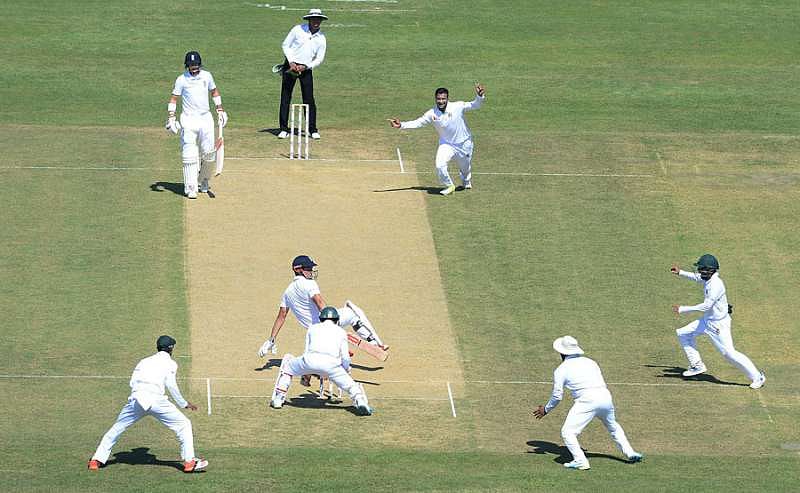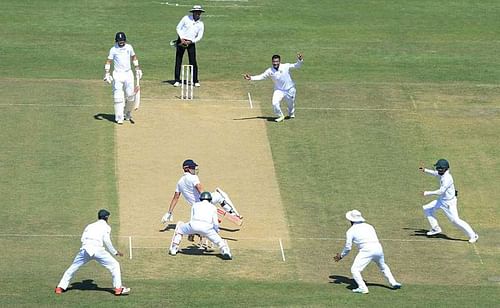
How the track at Chittagong made the Bangladesh and England battle enthralling
Ben Stokes, the tall and strong English allrounder, pitched the third ball of the 82nd over on a good length, which moved into Shafiul Islam after pitching and hit his front pad. Stokes and England appealed. The on-field umpire, Kumar Dharmasena, who had a wretched time in the middle throughout the Test match, raised his finger as he thought, Shafiul was not offering a shot.
Bangladesh reviewed, but the decision of the on-field umpire was upheld and thus, it brought an end to one of the most memorable Test matches of this year.
What a Test match it had been! It was full of eventful moments, well-orchestrated fight backs, exhibition of high profile all round capabilities of two of the best allrounders in the world at the moment, the story of two outstanding debutants – Sabbir Rahman and Mehedi Hasan, who gave the impression to everyone, they are the next big things not only in Bangladesh, but also for world cricket, and of course, the track without which, the story of Chittagong would not have been a part of Test cricket’s folklore.
The Chittagong deck
According to the modern day cricket experts, the definition of a good pitch is all about the ball coming into the bat nicely and scoring runs in plenty with little on offer for the bowlers. Such decks help to rearrange a batsman’s statistical achievement, but at the end of the day, Test cricket suffers a lot either due to dull draws or heavily one-sided contests.
The real charm of Test matches gets killed and thus, sow the seeds of doubts about the future of Test cricket and allow some so-called modern experts to sing the song about the death of Test cricket.
Meanwhile, the tracks which offer a bit for the bowlers and tests the batters, are termed as not ideal for Test cricket by the modern day experts. Such an opinion does leave one astonished. If one looks back at the story of the most exciting finishes in the history Test cricket, it was the ‘not ideal’ tracks and the bowlers hugely responsible for dishing out stories which became invaluable for the cricket writers and fans.
Also Read: Why Nagpur pitch should not be repeated
If I need to pick up the most important factor behind the epic clash at Chittagong, then, I would definitely vouch for the deck. From a modern day perspective, it was not an ideal deck and I must say, Test cricket was lucky to have such.
The track offered bounce on which the new ball bowlers were able to cash in and so were the spinners. As the day progressed, the track started to slow down, but not to a greater extent. The bounce varied and thus, created doubts in the minds of the batsmen. The spinners enjoyed bowling while, the English pacers, who are well-equipped to move the old ball, cashed in big time on this track.
Neither was it a minefield for the batsmen. It didn’t offer any scope to exhibit free-flowing strokeplay, but it wanted the batsmen to play the ball according to their merit. It wanted the batsmen to play the ball late and getting behind the line of the ball against the spinners and limited the batters from playing the pacers by getting towards the side of the ball. A bit of a gap between the bat and pad proved fatal and there was no place for sloppy foot-work.
Also Read: Why green tops should be criticized just as much as dust bowls for 'harming the quality of cricket'
The track helped us to enjoy the ebbs and flows of Test match cricket. It cut short the urge to exhibit crazy stroke-play and forced the batsmen to infuse composure and exhibit appropriate shot selections. For a single moment, dullness didn’t intervene at Chittagong and kept the spectators on the edge throughout the four and half intriguing days of Test match cricket.
Moreover, due to this track, the Bangladeshi cricket followers could understand the value of leaving the ball, occupying the crease and the importance of maneuvering the strike in a 5-day game.
The Bangladeshis love to relish boundary-based batting, but in Chittagong, they cheered when Sabbir took singles and twos, Mushfiq left the ball and Tamim Iqbal invested less faith in big shots. At the other end, they didn’t mind when the English batters hit big shots, but felt beaten, when Jonny Bairstow and Ben Stokes rotated the strike freely during that all important partnership in the third innings.
Also Read: Is 'Home Advantage' the critical factor in Test cricket?
Few months back, Sachin Tendulkar said, “The wickets need to change; they need to be more helpful for bowlers. In T20s, the greatest of bowlers are being reverse-swept. Three-hundred is no longer competitive in ODIs. So there should be at least one format where bowlers have a better chance of executing their skills and making it more interesting for spectators”.
Words of wisdom from the great man and one must not forget, in any format of the game, if the bowling has the upper hand, the contest becomes simmering. And if the bowlers are needed to make the contest a gripping one, the track has to be a sporting one.
The Bangladeshi curators prepared a fantastic track which enriched Test cricket a lot and for the survival of Test cricket, such tracks are a must.
